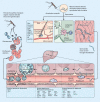Pre-erythrocytic malaria vaccines: identifying the targets
- PMID: 23176657
- PMCID: PMC3584156
- DOI: 10.1586/erv.12.92
Pre-erythrocytic malaria vaccines: identifying the targets
Abstract
Pre-erythrocytic malaria vaccines target Plasmodium during its sporozoite and liver stages, and can prevent progression to blood-stage disease, which causes a million deaths each year. Whole organism sporozoite vaccines induce sterile immunity in animals and humans and guide subunit vaccine development. A recombinant protein-in-adjuvant pre-erythrocytic vaccine called RTS,S reduces clinical malaria without preventing infection in field studies and additional antigens may be required to achieve sterile immunity. Although few vaccine antigens have progressed to human testing, new insights into parasite biology, expression profiles and immunobiology have offered new targets for intervention. Future advances require human trials of additional antigens, as well as platforms to induce the durable antibody and cellular responses including CD8(+) T cells that contribute to sterile protection.
Figures

References
-
- Hoffman SL, Oster CN, Plowe CV, et al. Naturally acquired antibodies to sporozoites do not prevent malaria: vaccine development implications. Science. 1987;237(4815):639–642. - PubMed
-
- Vanderberg JP. Plasmodium berghei: quantitation of sporozoites injected by mosquitoes feeding on a rodent host. Exp. Parasitol. 1977;42(1):169–181. - PubMed
Website
-
- [(Accessed 10 May 2012)];WHO Rainbow tables. http://www.who.int/vaccine_research/links/Rainbow/en/index.html.
Publication types
MeSH terms
Substances
Grants and funding
LinkOut - more resources
Full Text Sources
Other Literature Sources
Research Materials
